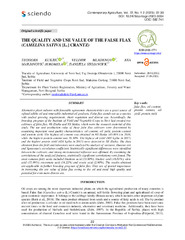Приказ основних података о документу
The quality and use value of the false flax (Camelina sativa [L.] Crantz)
| dc.creator | Kukrić, Teodora | |
| dc.creator | Mladenov, Velimir | |
| dc.creator | Marjanović-Jeromela, Ana | |
| dc.creator | Stojanović, Danijela | |
| dc.date.accessioned | 2023-05-23T11:59:02Z | |
| dc.date.available | 2023-05-23T11:59:02Z | |
| dc.date.issued | 2023 | |
| dc.identifier.issn | 2466-4774 | |
| dc.identifier.uri | http://fiver.ifvcns.rs/handle/123456789/3569 | |
| dc.description.abstract | Alternative plant cultures with favorable agronomic characteristics are a great source of refined edible oil and renewable industrial oil products. False flax stands out as a species with modest growing requirements, short vegetation and diverse use. Accordingly, the breeding program of the Institute of Field and Vegetable Crops in Novi Sad created two cultivars of false flax, NS Zlatka and NS Slatka, which were the research material of this study. The use and production value of these false flax cultivars were determined by examining important seed quality characteristics: oil content, oil yield, protein content and protein yield. The highest oil content was obtained in NS Slatka (45.90%) in 2016, while the highest protein content was 30.30%. The highest oil yield (801 kg/ha in 2017) and the highest protein yield (424 kg/ha in 2017) were detected in NS Zlatka. The data obtained from the field and laboratory were analyzed by analysis of variance, Duncan test and Spearman's correlation coefficient. Statistically significant differences were identified between the cultivars, and strong environmental influence was affirmed. By examining the correlations of the analyzed features, statistically significant correlations were found. The most common fatty acids included linolenic acid (33.80%), linoleic acid (18.81%), oleic acid (15.99%), eicosenoic acid (14.22%) and erucic acid (2.90%). The results obtained are applicable in further breeding program of false flax. They are of special importance in increasing the use value of false flax owing to the oil and meal high quality and potential for even more diverse use. | sr |
| dc.language.iso | en | sr |
| dc.publisher | Novi Sad : University of Novi Sad, Faculty of Agriculture | sr |
| dc.relation | APV 142-451-2297/2021-01/02: Lanik kao održiva biljna vrsta: karakterizacija i potencijal primene, financed by the Provincial Secretariat for Higher Education and Scientific Research, AP Vojvodina | sr |
| dc.relation | APV 142-451-2609/2021-01/02: Potencijal ulja od lanika i šafranike kao funkcionalnog dodatka u hrani za kućne ljubimce, financed by the Provincial Secretariat for Higher Education and Scientific Research, AP Vojvodina | sr |
| dc.relation | info:eu-repo/grantAgreement/MESTD/inst-2020/200032/RS// | sr |
| dc.relation | info:eu-repo/grantAgreement/MESTD/inst-2020/200117/RS// | sr |
| dc.rights | openAccess | sr |
| dc.rights.uri | https://creativecommons.org/licenses/by-nc-nd/4.0/ | |
| dc.source | Contemporary Agriculture | sr |
| dc.subject | false flax | sr |
| dc.subject | oil content | sr |
| dc.subject | protein content | sr |
| dc.subject | oil yield | sr |
| dc.subject | protein yield | sr |
| dc.subject | cultivars | sr |
| dc.subject | camelina | sr |
| dc.subject | Camelina sativa | sr |
| dc.subject | oil crops | sr |
| dc.title | The quality and use value of the false flax (Camelina sativa [L.] Crantz) | sr |
| dc.type | article | sr |
| dc.rights.license | BY-NC-ND | sr |
| dc.citation.epage | 30 | |
| dc.citation.issue | 1-2 | |
| dc.citation.rank | M24~ | |
| dc.citation.spage | 22 | |
| dc.citation.volume | 72 | |
| dc.identifier.doi | 10.2478/contagri-2023-0004 | |
| dc.identifier.fulltext | http://fiver.ifvcns.rs/bitstream/id/9514/amj_contagri.pdf | |
| dc.type.version | publishedVersion | sr |


